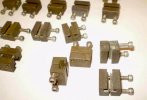delivery of oblivion
postman
Hello..I have not posted on here in ages.Due to a health issue i could no longer maintain the garden and railway as it was ans so at the end of last year a landscaper friend came in with a JCB and completely removed the garden and re did it for us,and i have re laid track on gravel effectively.Its nothing like the scenic railway we had before but at least i can run trains.All the fish plates have been totally cleaned out and track is regularly clean,yet i still have issues with trains stop starting and its a case of kicking the track and various places and the trains move again.I have not tried "Official" Peko conductivity paste in the rail joiners,although did experiment yrs ago with a copper greae which proved a disaster,getting all mixed up with mud,garden gunge,creating a nightmare !! The new railway will not have this issue at all...Is the conductivity paste worth using..? A friend who is not a g scale rail person suggested electrical contact cleaning spray..,in the fishplates.Would that be worth a go..? Thanks for any advice.I am also having to replace my over 20 yr old LGB 1 amp Controller and a Helmsmann 5 amp controller,also yrs and yrs old....Only controller i can see thats of reasonable price is the Gauge master G scale one,,which i belive gives out 2.5 amps...May get one of those to begin with.Cannot see anywhere where the LGB 1 amp controolers are being sold.ie the ones you used to get in a Starter set...no transformer required.Thanks for reading....Best Wishes,Ade

